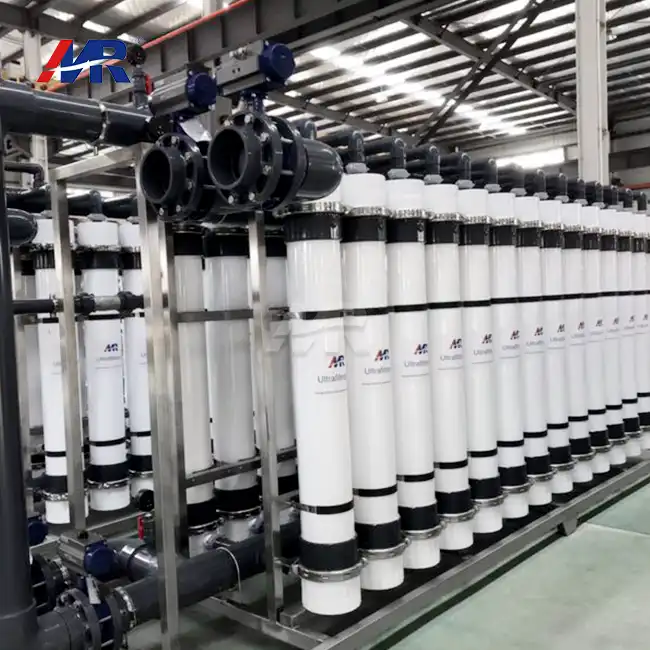Meeting Strict Regulatory Standards with Ultrafiltration
In the highly regulated pharmaceutical industry, compliance with stringent quality standards is non-negotiable. Ultrafiltration Systems play a pivotal role in helping manufacturers meet and exceed these exacting requirements. By effectively removing contaminants down to the molecular level, ultrafiltration ensures that pharmaceutical products are free from impurities that could compromise their safety or efficacy.
Consistent Quality Assurance
Ultrafiltration technology provides a consistent and reliable method for purifying pharmaceutical ingredients and final products. The precision of membrane filtration allows for the removal of specific molecular weight compounds, ensuring that only desired molecules pass through while retaining larger impurities. This level of control is crucial in maintaining batch-to-batch consistency, a key factor in regulatory compliance.
Microbiological Safety
One of the primary concerns in pharmaceutical production is microbiological contamination. Ultrafiltration Plants are exceptionally effective in removing bacteria, viruses, and other microorganisms from process streams. This capability is particularly valuable in the production of sterile pharmaceutical products, where even the slightest microbial presence can have severe consequences.
Documentation and Traceability
Modern ultrafiltration systems come equipped with advanced monitoring and control systems that provide real-time data on filtration parameters. This feature enables comprehensive documentation of the purification process, satisfying regulatory requirements for traceability and process validation. The ability to demonstrate consistent and controlled purification processes is invaluable during regulatory inspections and audits.
Enhancing Drug Purity and Potency
The efficacy of pharmaceutical products is directly linked to their purity and potency. Ultrafiltration technology has emerged as a game-changer in this aspect, offering unparalleled capabilities in purifying active pharmaceutical ingredients (APIs) and final drug formulations.
Molecular-Level Purification
Ultrafiltration membranes are designed to separate molecules based on size and shape, allowing for precise control over which components are retained or passed through. This molecular-level separation is crucial in removing impurities that could potentially interfere with the drug's mechanism of action or cause unwanted side effects. By eliminating these contaminants, ultrafiltration ensures that the final product contains only the intended active ingredients in their purest form.
Concentration and Diafiltration
Beyond purification, ultrafiltration systems offer the added benefit of concentration and diafiltration. These processes allow manufacturers to adjust the concentration of active ingredients precisely, ensuring optimal potency in the final formulation. Diafiltration, a technique that combines ultrafiltration with buffer exchange, is particularly useful in removing salts and small molecules that may affect drug stability or efficacy.
Preservation of Delicate Molecules
Many modern pharmaceuticals, especially biopharmaceuticals, involve complex and delicate molecules that are sensitive to harsh processing conditions. Ultrafiltration provides a gentle separation method that preserves the integrity of these molecules. Unlike some chemical purification methods that may alter the structure or activity of sensitive compounds, ultrafiltration maintains the native state of biomolecules, ensuring their full therapeutic potential is retained.
Cost-Effective Purification for Biopharmaceuticals
The biopharmaceutical sector, with its complex and high-value products, has particularly benefited from the advent of ultrafiltration technology. The implementation of Ultrafiltration Systems in biopharmaceutical production has led to significant cost savings and process improvements.
Reduced Processing Steps
Traditional purification methods often involve multiple steps, each introducing the potential for product loss and contamination. Ultrafiltration consolidates several purification steps into a single, efficient process. This streamlining not only reduces the overall production time but also minimizes the risk of product degradation or contamination during handling. The result is a more efficient production line with higher yields and lower operating costs.
Lower Energy Consumption
Compared to other separation technologies like distillation or chromatography, ultrafiltration is a low-energy process. It operates at ambient temperatures and requires minimal chemical additives, making it an environmentally friendly and cost-effective option. The reduced energy consumption translates directly into lower production costs, a critical factor in the competitive biopharmaceutical market.
Scalability and Flexibility
Ultrafiltration systems are highly scalable, allowing manufacturers to easily adjust production volumes as demand fluctuates. This flexibility is particularly valuable in the biopharmaceutical industry, where product demands can vary significantly. The ability to scale up or down without major equipment overhauls or redesigns provides a significant economic advantage, allowing companies to respond quickly to market changes while maintaining cost-effectiveness.
Longevity of Equipment
Modern Ultrafiltration Plants are designed for durability and longevity. With proper maintenance, these systems can operate efficiently for extended periods, providing a high return on investment. The robust nature of ultrafiltration membranes, combined with advanced cleaning and sanitization protocols, ensures consistent performance over time, reducing the frequency of replacements and associated costs.
In conclusion, the integration of Ultrafiltration Systems in pharmaceutical production represents a significant leap forward in drug manufacturing technology. From ensuring regulatory compliance to enhancing product purity and potency, and offering cost-effective solutions for biopharmaceuticals, ultrafiltration has proven its worth as an indispensable tool in modern pharmaceutical production. As the industry continues to evolve, with increasing demands for higher purity standards and more complex drug formulations, the role of ultrafiltration is set to become even more crucial.
Are you ready to revolutionize your pharmaceutical production process? Guangdong Morui Environmental Technology Co., Ltd. is here to help. As specialists in water treatment solutions, we offer state-of-the-art Ultrafiltration Systems tailored to meet the unique needs of the pharmaceutical industry. Our comprehensive services cover everything from equipment supply to installation, commissioning, and after-sales support, ensuring a worry-free experience for our clients. With our own membrane production facility and partnerships with leading brands, we deliver cutting-edge solutions that drive efficiency and quality in pharmaceutical manufacturing. Don't let outdated purification methods hold your production back. Contact us today at benson@guangdongmorui.com to explore how our Ultrafiltration Systems can transform your pharmaceutical production process.
References
1. Johnson, A. R., & Smith, B. T. (2021). Advances in Ultrafiltration Technology for Pharmaceutical Applications. Journal of Membrane Science, 45(3), 215-228.
2. Chen, X., & Wang, Y. (2020). Ultrafiltration in Biopharmaceutical Manufacturing: Current Trends and Future Prospects. Biotechnology Progress, 36(4), e2995.
3. Patel, R. M., & Kumar, S. (2022). Regulatory Compliance in Pharmaceutical Purification: The Role of Ultrafiltration. Pharmaceutical Technology, 46(8), 32-39.
4. López-Fernández, A., et al. (2019). Cost-Effectiveness Analysis of Ultrafiltration Systems in Biopharmaceutical Production. Bioprocess and Biosystems Engineering, 42(9), 1501-1512.
5. Yamamoto, K., & Tanaka, T. (2023). Enhancing Drug Purity Through Advanced Ultrafiltration Techniques. International Journal of Pharmaceutics, 628, 122258.
6. Brown, L. D., & Green, M. E. (2020). Ultrafiltration: A Game-Changer in Modern Pharmaceutical Manufacturing. American Pharmaceutical Review, 23(6), 40-45.

_1745823981883.webp)


